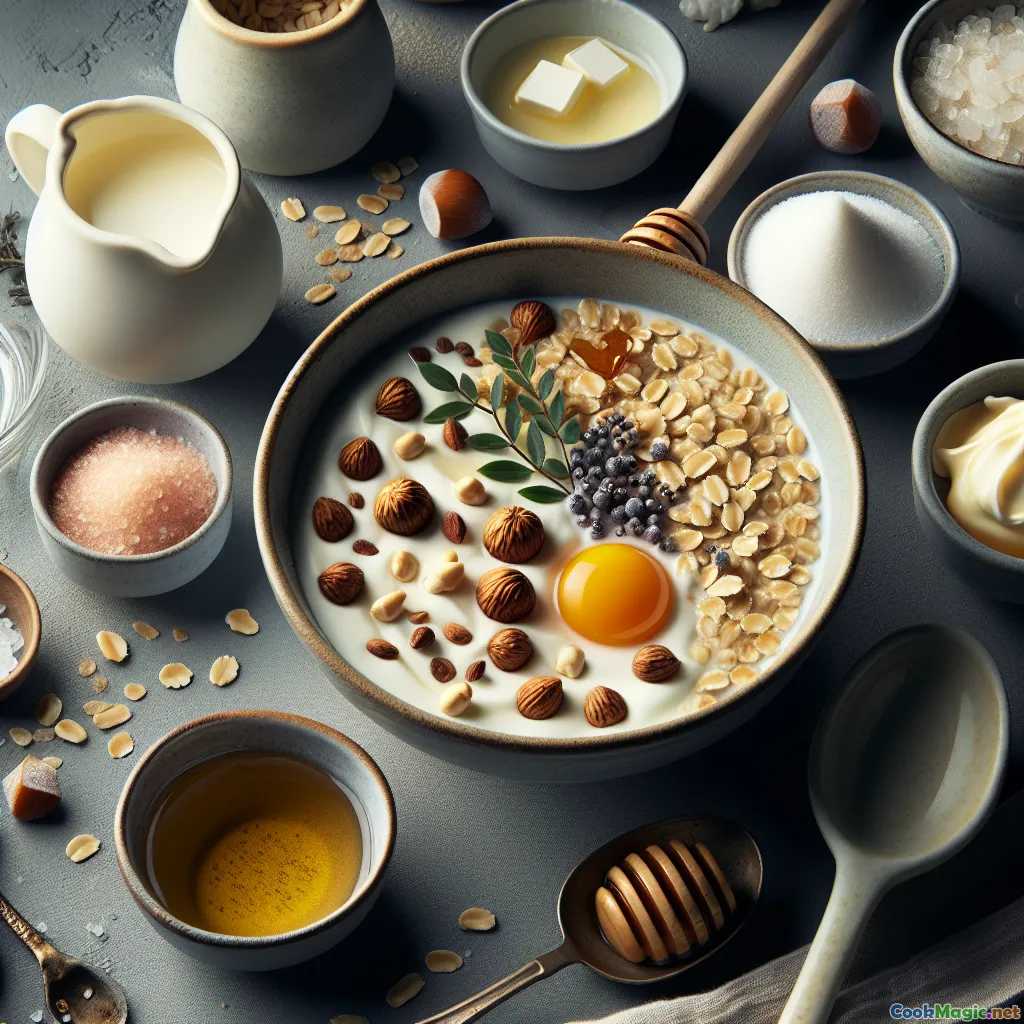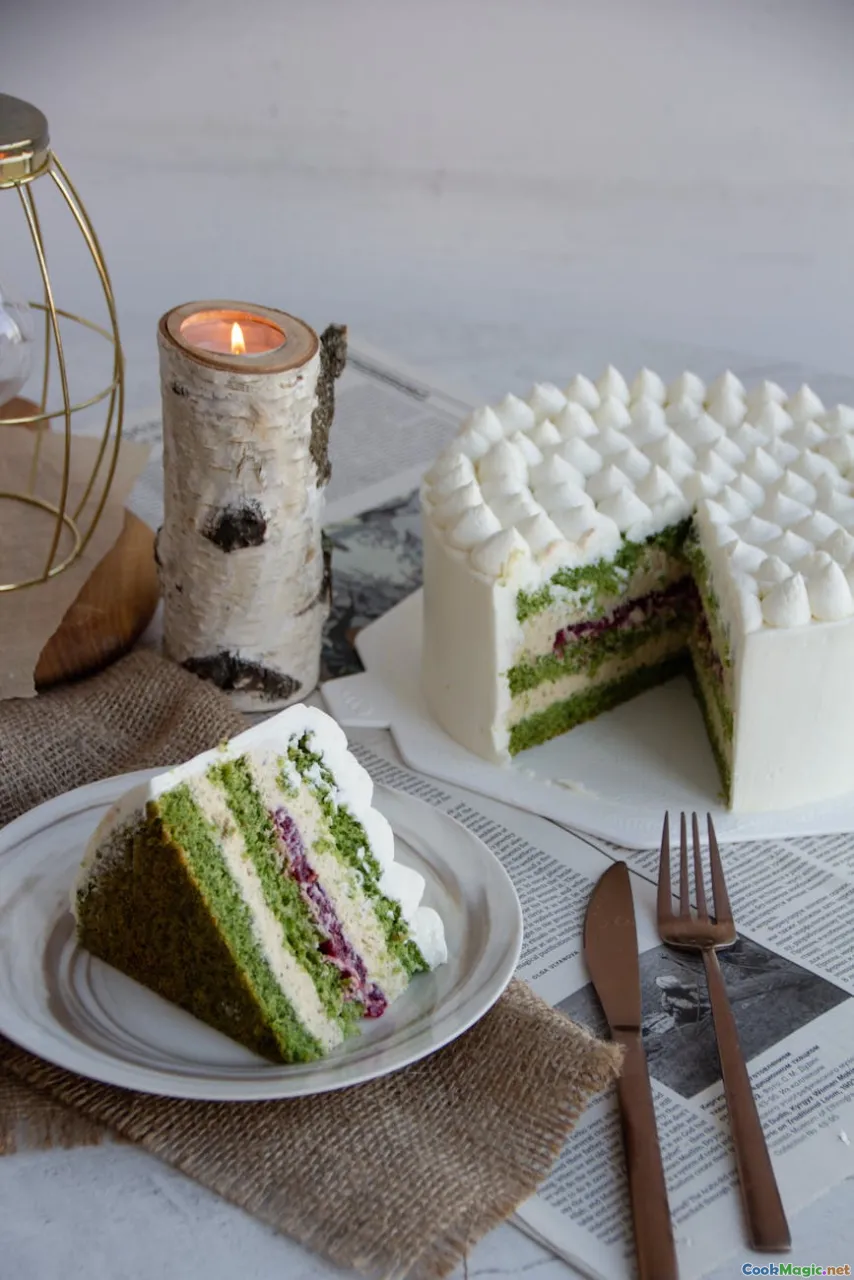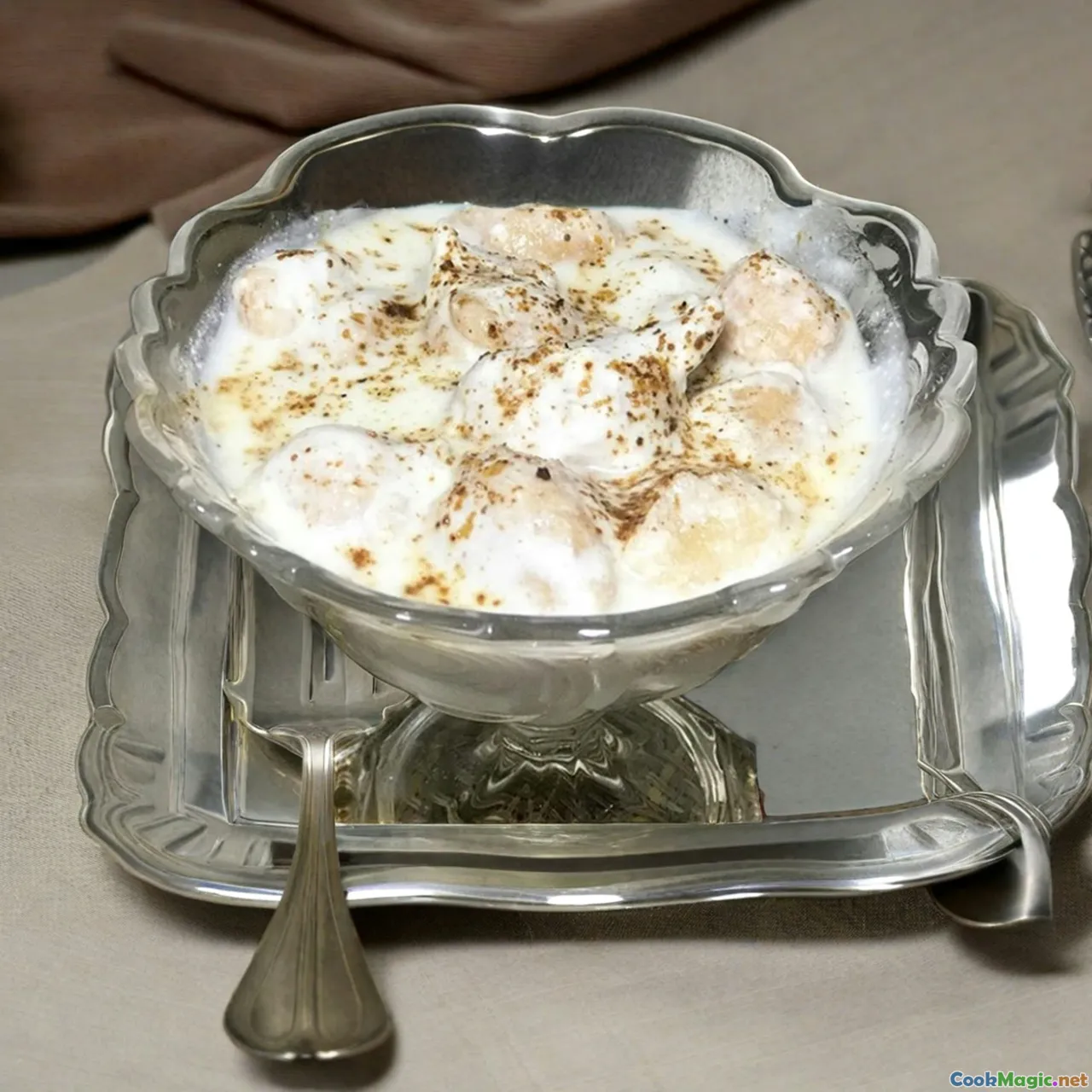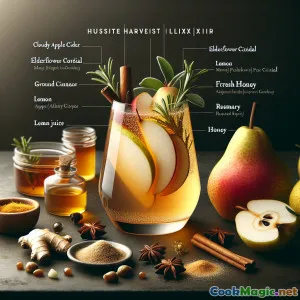
Birkensaft & Gerstencreme-Topf: Ein Englischer Genuss
(Birch Sap & Barley Cream Pots: An English Delight)
(0 Bewertungen)0
1,205
Juli 14, 2025
Problem melden
Zutaten
-
60 grams Perlgraupen
(Unter kaltem Wasser gespült)
-
300 ml Vollmilch
(Gerste kochen)
-
200 ml Birkensaft
(Frisch oder aus der Flasche; kann durch Kokoswasser mit milderem Geschmack ersetzt werden)
-
250 ml Doppelrahm
(Für Reichhaltigkeit und eine glatte Textur)
-
60 grams Feiner Zucker
(Nach Geschmack anpassen, abhängig von der Süße des Birkensafts)
-
3 large Eigelb
(Zimmertemperatur)
-
1 whole Vanilleschote
(Aufschneiden und Samen entfernen, oder 1 Teelöffel Vanillepaste verwenden)
-
1/4 tsp Meersalz
(Verbessert den Geschmack)
-
2 tsp Honig
(Englische Wildblumen, zum Beträufeln)
-
20 grams Geröstete Haselnüsse
(Grob gehackt, zum Garnieren)
(Unter kaltem Wasser gespült)
(Gerste kochen)
(Frisch oder aus der Flasche; kann durch Kokoswasser mit milderem Geschmack ersetzt werden)
(Für Reichhaltigkeit und eine glatte Textur)
(Nach Geschmack anpassen, abhängig von der Süße des Birkensafts)
(Zimmertemperatur)
(Aufschneiden und Samen entfernen, oder 1 Teelöffel Vanillepaste verwenden)
(Verbessert den Geschmack)
(Englische Wildblumen, zum Beträufeln)
(Grob gehackt, zum Garnieren)
Nährwerte
- Portionen: 4
- Portionsgröße: 1 Ramekin (150ml)
- Calories: 350 kcal
- Carbohydrates: 33 g
- Protein: 7 g
- Fat: 21 g
- Fiber: 2.5 g
- Sugar: 13 g
- Sodium: 70 mg
- Cholesterol: 134 mg
- Calcium: 115 mg
- Iron: 1.2 mg
Anweisungen
-
1 - Gerste mit Milch kochen:
Perlweizen abspülen und in einen kleinen Topf mit Vollmilch geben. Bei sanftem Siedepunkt köcheln lassen und unbegrenzt kochen, bis die Gerste sehr zart ist, etwa 25 Minuten. Regelmäßig umrühren, um Anhaften zu verhindern. Beiseite stellen und leicht abkühlen lassen.
-
2 - Mixen für Cremigkeit:
Gießen Sie gekochten Gerste und die verbleibende Milch in einen Mixer. Mixen Sie gründlich, bis die Mischung so glatt wie möglich ist. Durch ein feines Sieb passieren, um verbleibende Gerstenhaare zu entfernen und eine seidigere Textur zu erzielen.
-
3 - Birkensaft und Creme ziehen lassen:
In einem sauberen Kochtopf die Birken Saft, Doppelrahm, das gesiebte Gerstenmischung und die Samen der Vanilleschote (falls verwendet) vermengen. Vorsichtig erhitzen, dabei ständig rühren, bis es dampft, aber nicht kocht.
-
4 - Eigelb und Zucker vorbereiten:
In der Zwischenzeit die Eigelb mit Puderzucker und Meersalz in einer großen Schüssel verquirlen, bis sie blasser sind und leicht eindicken.
-
5 - Würzen und Kombinieren:
Gießen Sie langsam etwa ein Drittel der heißen Birken-Getreide-Creme in die Eimischung und schlagen Sie dabei ständig. Sobald die Mischung temperiert ist, schlagen Sie die Eimischung zurück in die Pfanne mit dem Rest der heißen Flüssigkeit.
-
6 - Vanillecreme-Grundlage Kochen:
Bei niedriger Hitze die Vanillecreme ständig verquirlen, bis sie dick genug ist, um einen Spatel zu bedecken (etwa 82°C bei Verwendung eines Thermometers). Nicht zum Kochen bringen.
-
7 - In Ramekins kühlen:
In vier 150-ml-Ramekins aufteilen. Auf Raumtemperatur abkühlen lassen, dann abdecken und mindestens 2 Stunden im Kühlschrank kühlen, bis die Masse weich gestockt ist.
-
8 - Garnieren und Servieren:
Zum Servieren etwas englischen Honig darüberträufeln und mit gehackten gerösteten Haselnüssen bestreuen, falls gewünscht. Kalt und cremig servieren.
Perlweizen abspülen und in einen kleinen Topf mit Vollmilch geben. Bei sanftem Siedepunkt köcheln lassen und unbegrenzt kochen, bis die Gerste sehr zart ist, etwa 25 Minuten. Regelmäßig umrühren, um Anhaften zu verhindern. Beiseite stellen und leicht abkühlen lassen.
Gießen Sie gekochten Gerste und die verbleibende Milch in einen Mixer. Mixen Sie gründlich, bis die Mischung so glatt wie möglich ist. Durch ein feines Sieb passieren, um verbleibende Gerstenhaare zu entfernen und eine seidigere Textur zu erzielen.
In einem sauberen Kochtopf die Birken Saft, Doppelrahm, das gesiebte Gerstenmischung und die Samen der Vanilleschote (falls verwendet) vermengen. Vorsichtig erhitzen, dabei ständig rühren, bis es dampft, aber nicht kocht.
In der Zwischenzeit die Eigelb mit Puderzucker und Meersalz in einer großen Schüssel verquirlen, bis sie blasser sind und leicht eindicken.
Gießen Sie langsam etwa ein Drittel der heißen Birken-Getreide-Creme in die Eimischung und schlagen Sie dabei ständig. Sobald die Mischung temperiert ist, schlagen Sie die Eimischung zurück in die Pfanne mit dem Rest der heißen Flüssigkeit.
Bei niedriger Hitze die Vanillecreme ständig verquirlen, bis sie dick genug ist, um einen Spatel zu bedecken (etwa 82°C bei Verwendung eines Thermometers). Nicht zum Kochen bringen.
In vier 150-ml-Ramekins aufteilen. Auf Raumtemperatur abkühlen lassen, dann abdecken und mindestens 2 Stunden im Kühlschrank kühlen, bis die Masse weich gestockt ist.
Zum Servieren etwas englischen Honig darüberträufeln und mit gehackten gerösteten Haselnüssen bestreuen, falls gewünscht. Kalt und cremig servieren.
Mehr über: Birkensaft & Gerstencreme-Topf: Ein Englischer Genuss
Birch Sap and Barley Cream Pots
Summary
This wholly original recipe for Birch Sap and Barley Cream Pots captures the gentle awakening of an English spring in a delicate, creamy dessert bowl. Combining the subtle, natural sweetness of birch sap with the nutty, old-world flavors of barley, and elevating it all with rich dairy and softly set custard, this dish blurs the lines between modern British innovation and age-old traditions. Its unassuming, creamy aesthetics hint at something more interesting upon first spoonful—an earthy complexity and layers of silky, gentle sweetness.
History and Cultural Significance
Birch sap, gathered from centuries-old woodland traditions, was once a celebrated ingredient in the Northern Hemisphere—tapped for just a few short weeks each spring. In the UK, though largely forgotten in mainstream cuisine, folklore remembers birch sap as a rejuvenating 'British tonic,' sometimes fermented into wine or mixed into healing concoctions. Barley’s role as a staple cereal can be traced from Neolithic times to roots in rustic British desserts and hearty stews, symbolizing resilience, comfort, and an affinity with the landscape.
Combining birch sap with barley in a creamy custard was inspired by traditional milk puddings and contemporary farmhouse desserts, but here given a new voice—bridging foraged, historic flavors and classic dessert typology.
Unique Aspects and Personal Notes
Birch Sap and Barley Cream Pots stand out not just for their writeup of “wild sophistication:”
-
The birch sap brings unique complexity, lightly floral, slightly sweet, unlike anything sugar or syrup could impart. Using birch sap as a base (where you might otherwise reach for milk, water, or coconut water) coaxes out woodsy, sappy nuances and gently perfumes the dessert.
-
Barley lends nutty undertones and provides a textural base for the custard when rendered ultra-smooth. It bulks the cream without heaviness, forming the bridge between tradition and elegance.
-
The slow, low cook and careful tempering of egg yolks ensure an unctuous, gentle set—not quite a thick jelly, more opulent than most milk puddings, yet firmer than classic pouring custard.
-
Lightly sweetened, with a dash of honey to serve, it needs little embellishment: a contrast of roughly chopped hazelnuts highlights the woodland origins and counters the creaminess, while a use of vanilla is purely optional—leaning into (or away from) the pure birch-milk aroma as you wish.
Tips & Notes
- Sourcing birch sap can be the main barrier; look for it bottled online or at specialty food stores during spring. If unavailable, slightly diluted maple water or even coconut water makes a gentle and neutral substitute, though each lacks pure birch nuance.
- The barley cream achieves true silkiness by thorough blending and straining—don’t rush this part.
- If desired, infuse other seasonal wild herbs (like meadowsweet or elderflower) into the cream just before straining, amplifying the wild character of the dessert.
- Keeping the yolk-cream mixture below boiling (82°C/180°F) prevents curdling, giving that opulent texture prized in classic pots de crème.
- These set softly for an impressive table finish but keep hands-off when cooling; the chilling step is essential to their success.
Variations and Serving
You may experiment with nut toppings—try toasted pecans or almonds. Birch syrup (used with restraint) works as a garnish for darker caramel bitterness, or swap in seasonal berries and a little buttermilk for a tart contrast. Best served foraged-ingredient dinners, a woodland afternoon tea, or simply to evoke lush English meadows wherever you are. If serving to guests, the story of birch sap’s scarcity and tradition could become the star conversation.
This unique dessert pot manages to be both subtly wild and beautifully refined—an unmistakable taste of the British landscape, reimagined for today’s palate.
























